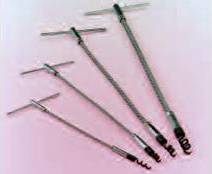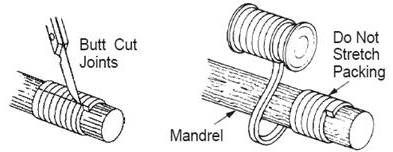Control of fluid loss is essential for the successful operation of mechanical equipment used in fluid handling. Various methods are utilized to control leakage at equipment shafts / rods, or valve stems. The original and still most common of these sealing devices is the compression packing. It is also known as gland packing.
Compression packing consists of a number of rings which are inserted into the annular space (stuffing box) between the rotating or reciprocating member and the body of the equipment or valve. By tightening a follower against the top or outboard ring, pressure is transmitted to the packing set, expanding the rings radially against the side of the stuffing box and the reciprocating or rotating member, effecting a seal. Compression packings are relatively easy to install and maintain.
In this article information is give on purpose for control of fluid loss, packing materials and construction, material selection, equipment condition and installation instructions.
Purpose for control of fluid loss
- To minimize pollution in environment.
- Plant esthetics (clean shop).
- Survivability of the fluid handling equipment itself.
- Minimize product loss.
- Human safety.
Packing materials and construction
Compression packings are made in a variety of shapes, sizes and constructions, from a wide range of materials. They are made from aramid, asbestos, carbon / graphite filament, fiberglass, flexible graphite, PTFE, synthetic fibers, etc. For more information on packing material please refer article on Gaskets – Material and Types.
The following describes the most commonly used constructions.
Braid-Over-Braid

Round braiding machines braid tubular jackets using yarns, rovings, ribbons and various other materials, either alone or in combination. Size is obtained by braiding jackets one over the other (braid-over-braid). They are relatively dense and are recommended for high pressure, slow-speed applications such as valve stems.
Braid-Over-Core

Finished product is produced by round braiding one or more jackets over a core.
Square Braid

Yarns, rovings, ribbons and other various materials, either alone or in combination, are processed on equipment where strands pass over and under strands running in the same direction. The packing is usually soft and can carry a large percentage of lubricant. Square braided packings are easy on equipment and are generally used for high-speed rotary service at relatively low pressure. The packing’s softness makes it ideal for old or worn equipment.
LATTICE BRAID®

Yarns, rovings, ribbons and other forms of various materials, either alone or in combination, are processed on equipment where the strands crisscross from the surface diagonally through the body of the packing. Each strand is strongly locked by other strands to form a solid integral structure that cannot easily ravel or come apart in service. LATTICE BRAID® packings are suitable for applications on both reciprocating and centrifugal pumps, valves, etc.
Die-Formed
Many compression packing materials are supplied in a pre-compressed ring form, which provides controlled density and size.
Mandrel Cut
Rings formed by wrapping braided stock of the required cross section on a mandrel or shaft with a diameter equal to the desired I.D.
Graphite Tape
Flexible graphite tape (ribbon) is manufactured by exfoliating (expanding) and then compressing natural graphite flakes to a specific density. Graphite has almost universal chemical inertness and is naturally lubricious, compactible and resilient, as well as nuclear radiation resistant.
Material selection
Packing manufacturers make packing for vide variety of application and are sold under their style number / brand names. Information on these products is available in their product catalogue. Selection of packing material shall be carried out based on the operating condition of the equipment. Six parameters of the equipment shall be considered for packing selection. The acronym “STAMPS†is commonly used to designate these parameters.
S = Size — cross section
T = Temperature — of media being sealed
A = Application — type of equipment (i.e., pumps, valves, reciprocating, rotating, etc.)
M = Media — material being sealed
P = Pressure — of media being sealed
S = Speed — shaft speed in fpm (pumps only)
Equipment condition
Condition of equipment is critical for the success of a packing. Following is recommended for valves and pumps.
Valves
Longitudinal scores on the valve stem are not to exceed 1/32″ depth and/or a depth-to-width ratio greater than 1.00.
Stem finish shall be less than 32 (micro inches) AARH.
Stuffing box finish is recommended to be 125 (micro inches) AARH.
Valve stem warpage / runout must be checked and shall not exceed following:
| Stem Diameter | Total Indicator Runout / ft |
|---|---|
| Up to and including 1.500″ (38.1 mm) | ±0.010″ |
| 1.501″ to 3.000″ (38.1 mm to 76.2 mm) | ±0.020″ |
| 3.001″ (76.2 mm) and above | ±0.040″ |
Pumps
Runout: TIR (Total Indicator Runout) not to exceed 0.005″.
Longitudinal scores: Should not be present on pump shaft or sleeve.
Shaft / Sleeve finish: 16 to 32 (micro inches) AARH
Stuffing Box Bore finish: 125 (micro inches) AARH
Stuffing box depth = (5.5 to 7.5) x packing cross section (CS)
Note:
- The bottom of the gland follower should be flat.
- Only small clearance (few thou) shall be there between stem / shaft and stuffing box bottom. If clearance is more, use bottom ring (junk ring) to prevent extruding the packing when it is compressed.
- If stuffing box bottom is beveled, it is recommended to use a system-compatible braided packing ring before installing selected packing.
- Burrs shall not be there on the stem and/or stuffing box bore walls.
Installation instructions
Remove all old packing from the stuffing box. Clean box and stem / shaft thoroughly and examine for wear and scoring. Replace stem / shaft if wear is excessive.

Use packing extractors to remove old packing rings. They have a long flexible shank to gain access to glands in difficult positions. The corkscrew tips are designed to embed firmly in all types of packing, including badly worn and hardened products. A T-handle provides good grip for both screw action and the efficient removal of packing.
Measure and record stem / shaft diameter, stuffing box bore and box depth. To determine the correct packing size, measure the diameter of the stem / shaft (inside the stuffing box area if possible), and the diameter of the stuffing box bore. Subtract the I.D. measurement from the O.D. measurement, and divide the difference by two. This is the required cross-sectional size.
Always cut the packing into individual rings. Never wind the packing into a coil in the stuffing box. Rings should be cut with a butt joint. Cut rings by using a spare stem / shaft, a mandrel with the same diameter as the stem or a packing cutter.

Hold the packing tightly on the mandrel, but do not stretch excessively. Cut the ring and insert it into the stuffing box, making certain that it fits the packing space properly. Alternatively packing rings may be cut using packing ring cutter (cutting jig).
Install one ring at a time in the stuffing box. Make sure it is clean, and has not picked up any dirt in handling. Seat each ring firmly, making sure it is fully seated before the next ring is installed. A tamping tool may be used for this. Joints of successive rings should be staggered and kept at least 90 degree apart. While installing packing rings in pumps, lubricate the I.D. of each ring lightly. When enough rings have been individually seated so that the nose of the gland follower will reach them, bring down the gland follower and apply load with the gland bolts as under.
Load application in valves
After the last ring is installed, bring down the gland follower and apply 25% to 35% compression to the entire packing set. Tighten gland bolts evenly. During tightening, turn the valve stem back and forth to determine easy of turning.
Load application in pumps
After the last ring is installed, bring the follower down on the packing and finger-tighten the gland nuts. Do not jam the packing by excessive gland loading. Start pump, and tighten the bolts until leakage is decreased to a tolerable minimum and the pump is running cool. Tighten the gland nuts one flat at a time. Make sure gland bolts are tightened evenly. Stopping leakage entirely at this point will cause the packing to burn up.
Note for pumps:
If a lantern ring is provided, make sure the lantern ring is installed under the pipe tap hole.
Internet site address of some compression packing manufacturers
http://www.garlock.com
http://www.jameswalker.biz
http://www.inmarco.com
http://www.champion-india.com
Acknowledgement:
This article is written based on technical information from Garlock Sealing Technologies. For more information please refer to their website – http://www.garlock.com
